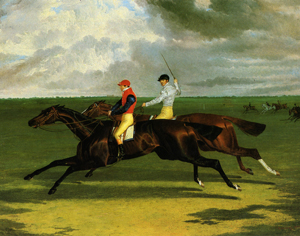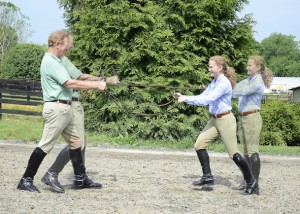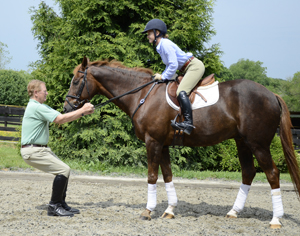The normal Preliminary cross-country course has approximately 25 jumping efforts. At the same time, your horse will take well over 600 strides at the gallop while completing a two-mile Prelim course. Since you will spend far more time galloping than you will jumping, it follows that you need to study the galloping position. If your position is weak or inefficient, it will have a substantial effect on your horse’s performance. Fortunately, there is now scientific research to help you determine the correct galloping position.

In the August 2009 issue of Science, researchers from the Structure and Motion Laboratory at England’s Royal Veterinary College, in partnership with the British Racing School at Newmarket, published a study on the effects of human posture on racehorse performance (“Modern Riding Style Improves Horse Racing Times” by Dr. Thilo Pfau, PhD, and others, Science 325, 289). The study proved what horsemen have believed for over a century–that the position modern jockeys use is the most efficient galloping position.
American jockey Willie Simms first used this coiled, crouching position in England in 1895, but it was his fellow American James F. “Tod” Sloan who popularized the new position. Sloan’s success rate during this period (in 1898 he won an astounding 46 percent of his races) forced the rest of that era’s jockeys to abandon their traditional long stirrups and upright position. This new position led to the greatest incremental change in racehorse times ever recorded: In the decade between 1895 and 1905, average racehorse times improved between 5 and 7 percent. (Since then, times have only improved 1 percent.)
A Revolution in Riding
The 1895-1905 decade must have been an exciting time to be a horseman, considering that Federico Caprilli was inventing the “forward seat” during the same period. Caprilli had as transformative an effect on jumping as Simms and Sloan had on galloping. The obvious connection between the two revolutionary positions is that both place the weight of the rider over the withers in a poised, elastic connection with the horse.
The RVC study analyzed the workload on galloping horses, first using sandbags and riders seated upright on the horses and then using jockeys crouched over the withers in their typical galloping positions. The study concluded that when sandbags or upright riders were in the saddles, the metabolic and mechanical costs to the horses were proportionate to the loads carried on their backs. However, when jockeys crouched over the withers, the metabolic and mechanical loads were reduced. In effect, when riders use a poised position, horses have only to carry the riders’ weight, but they are not burdened by having to accelerate the riders’ weight during each stride. (As an aside, this study probably answers the long-running argument among horsemen about “live weight versus dead weight.” It looks to me as if the live-weight supporters win.)
One important finding of the study is that each time horses take a galloping stride, there is a vertical displacement of their withers as well as the horizontal reach of their legs. This means that if riders stand straight-legged, each stride horses take must push the weight of the riders up, as well as carry the riders’ weight forward. In effect, a straight-legged rider is driving his weight straight down into his horse’s withers, while a ?rider who gallops with a bent knee “floats” over his horse.
A coauthor of the study, Alan Wilson, noted that by floating above their horses, jockeys save energy that would otherwise be used to push the weight of the riders up during each stride. Wilson says that efficient jockeys “don’t follow the movement of the horse, but stay relatively stationary.” Wilson continues, “If he pushes at the right time, it looks as if they (sic) can drive a horse much like a child propels a swing.” He goes on to note that because the rider is using his legs as pistons or shock absorbers, “This is hard work.” Jockeys’ heart rates recorded during races have reached 190 beats per minute.
The RVC study referenced an interesting analogous human study done by Lawrence Rome of the University of Pennsylvania. Rome experimented with backpack design and established that suspending a backpack on bungee cords within a frame caused the weight of the backpack to move less in relation to the carrying human’s movement, with a corresponding lessening of the workload.
The Message for Eventers
In the RVC summary, Dr. Pfau states, “Our research shows that it would be difficult or impossible for jockeys to isolate themselves from the movement of the mount were they seated or adopting an upright, straight-legged posture. We surmise that a jockey in the crouched position uncouples himself from the horse by moving relative to his mount. Interestingly, we also found that, in adjusting his position, the jockey slightly overcompensates for the horse’s motion. So, the fluctuations in the displacement and velocity of the combined horse and jockey may be slightly smaller than those of the horse alone.”

Naturally, the implications of the RVC study for the eventing world are obvious and important. Our first responsibility as horsemen is to the comfort and well-being of our horses. When we discover a position that ensures their comfort and makes them more efficient while they perform the tasks we require of them, we need to make sure we use that position. I would be the first to caution people not to ride cross-country at the same stirrup length as flat-race jockeys. This position would be too extreme for riders who have to jump over changing terrain, up banks, down drops and so on. However, we can certainly use the principles identified in the RVC study: elasticity, efficiency, poise and balance.
Of all these principles, I would choose balance as the most important for event riders, because our balance on our horses has such a tremendous effect on their balance. Straight-legged riders are inherently unstable. It is a position analogous to a needle balanced on its point: Any outside influence will cause the needle to topple. This potential instability is the reason straight-legged riders have to brace their hands against their horses’ necks. I disapprove of this position, both because of the lack of stability and because pressing the knuckles down on the neck locks the riders’ hands, making it impossible to maintain elastic, following hands at all times.
Angles Give You Leverage
It is a fact that most of our horses take a keen interest in their cross-country work and can require us to use a connection with their mouths that, while hopefully elastic, is occasionally extremely firm as well. We need a position that allows us to control our horses cross-country, while we continue to conform to the general principles determined by the RVC study. Again, a straight-legged position is inefficient when horses become overly enthusiastic. Because riders standing upright have no angles in their positions, they must either lean backward to strengthen the contact or resort to sharp bits for control.

A rider using the position recommended in the RVC study has a surprising amount of leverage, once they have been shown how to use it. I encourage riders with overly enthusiastic cross-country horses to use this leverage rather than sharp bits for control. Due to the increased speed of cross-country at Prelim and above, we need to ride with our stirrups shorter than for show jumping. The onlooker should notice that when the cross-country rider is seated, the angle of the knee is slightly less than the 90-degree angle I advocate for show jumping. (I recommend that lower-level riders maintain the same length of stirrup leather for show jumping and cross country–a 90-degree angle behind the knee when seated.)
My thinking is that the slow speeds of the lower levels do not require us to incline our bodies forward to any great degree. In addition, many entry-level riders do not yet have the fitness and stability required to ride with shorter stirrups. The relationship between your length of stirrup leather and your saddle’s design is an important concept as well.
See also: Make Sure Your Jumping Saddle Fits You, Too.
The leverage of our galloping positions should always be used so our hands and arms act through our horses’ toplines, rather than against their mouths. For example, when your horse starts to pull, I want you to lower your hips toward the saddle and shift your center of gravity a little farther back without sitting down on the saddle. Your restraining action should then be confined to squeezing your hands at the base of the withers and in line with his topline, reinforced by a single bridge of the reins if necessary. I want your hands to ask your horse to wait with his forehand while his hindquarters catch up, rather than trying to shorten his neck. This is similar to the action you use in dressage when you close your leg and wait with your hand for your horse to soften his mouth. The only difference is that at higher speeds you do not need to close your leg; your horse is already swinging his hindquarters under his body due to the mechanics of the gallop. Remember to soften your hand once your horse softens his mouth and gathers his stride.
The reason for the low hand placement is the moment we put our hands higher than our horses’ mouths, we are starting to confront his strength with our strength and, according to the laws of physics, that is a confrontation we will lose every time. You can see from that you have a surprising amount of leverage when you apply the technique illustrated here. If you have ever wondered how 100-pound exercise riders are able to control 1,000-pound racehorses, this is the answer. They sit still and use leverage.

In addition, those riders are incredibly fit. I would guess that at least half of the cross-country riders I see standing upright in their stirrups are doing so because they are not fit enough to maintain a poised, elastic position. This is not efficient or safe, but it is understandable and fixable.
Speaking of safety, it was readily apparent to me while I watched the 2011 Rolex that horse fatigue played a major role in some of the difficulties riders encountered, especially late in the four-mile course. I can’t help but wonder if some of those problems might have been avoided if the riders had been fitter and had adopted a more efficient galloping position. While an upright position is easier on the rider, science has shown us that a poised, elastic position is easier on the horse.
This article originally appeared in the August 2011 issue of Practical Horseman.










